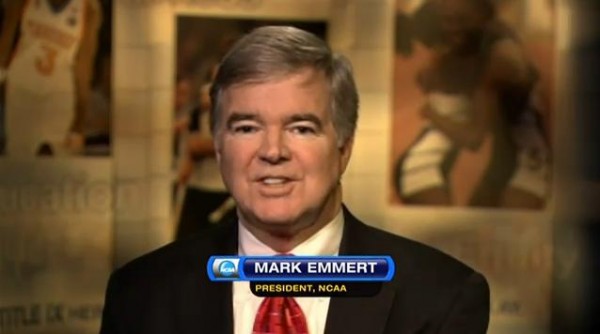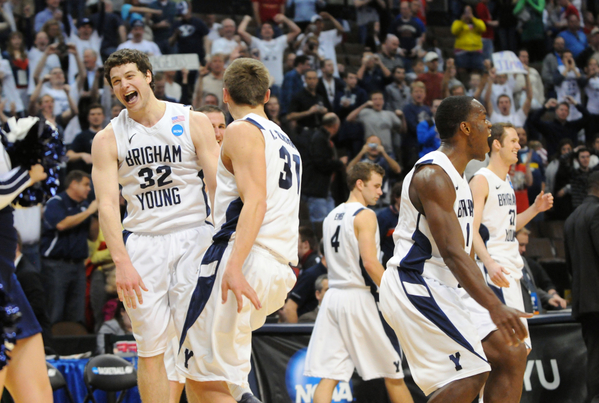$2,000 Stipend: Is the NCAA on the Verge of Allowing Payments to Players?
Posted by rtmsf on October 24th, 2011Perhaps the winds of change are in the air after all. Not a month after Taylor Branch’s opus in The Atlantic excoriated the NCAA for its stubborn adhesion to the twin tenets of amateurism and the “student-athlete,” and not five months after Big Ten commissioner Jim Delaney floated an idea to provide a “full cost of attendance” stipend to its players, the NCAA’s president, Mark Emmert, appears to be on board. Emmert told the Knight Commission on Intercollegiate Athletics Monday that he feels the time is ripe for addressing such an inequity for the first time in a couple of generations. What does the NCAA say the gap between the value of tuition, fees, room, board, and books versus the full cost of attendance amounts to? Try $2,000 per year.
This week, I’ll be asking the board to support a proposal to allow conferences — not mandate anyone, but allow conferences, not individual institutions — to increase the value of an athletic grant in aid to more closely approach the full cost of attendance. […] We are going to create a model that would allow — probably… up to $2,000 in addition to tuition, fees, room and board, books and supplies.
Interesting. A couple of grand may not seem like much considering the astronomical dollar figures that schools make on the backs of these players, but it’s not insignificant either. A two-semester school year encompasses roughly nine months for an athlete: dividing that figure by 39 weeks results in an allowance of roughly $51 per week. What college student couldn’t use a little shy of ten bucks a day to buy pizza, fill up his gas tank and occasionally join his buddies for an evening out to the movies and some greasy spoon afterward? It seems a pittance given the figures going into the coffers of the power conference schools, right? But therein lies the problem.
Emmert clearly stated that the plan would allow conferences to enact these stipends, which could fundamentally change how schools throughout college sports recruit their athletes. If every single one of Ohio State’s one thousand athletes, for example, were given the extra $2,000 as part of their grant-in-aid packages, the school would take roughly a $2 million net loss on the deal. Considering, however, that OSU football profited by $24 million and OSU basketball by another $10 million in 2009-10, it’s difficult to believe that the Buckeye athletics program couldn’t take the immediate hit. In fact, given the competitive advantage that it would engender for recruiting the most elite athletes in all sports, it appears to be a great investment!
When it comes down to it, this policy initiative could be another step toward the permanent stratification of college basketball between the haves and have-nots. The conferences whose schools have the big-money BCS payouts, rich television contracts and massive alumni bases stand to prosper — an extra couple of mil isn’t going to slow those programs down at all. But the mid-major leagues, even those at the top of that stratus like the Mountain West, Conference USA, Atlantic 10 and others, are going to have to get very creative in order to offer the extra $2,000 benefit equally across its member institutions. Even if a school like BYU in the WCC might be able to afford such a change, can Portland and Pepperdine? Memphis basketball won’t want to lose ground to its competitors in the Top 25, but can it convince Southern Miss and Marshall that this is an economically viable idea for the rest of C-USA?
The short answer is: probably not. The critique that Seth Davis made in his response to Branch’s piece is that the vast majority of Division I programs are not profitable. He’s correct in that assessment, of course, but the six power conferences are beholden only to themselves and are willing to destroy the other 26 basketball conferences if it means they continue to enrich themselves. Those 70+ programs generally are profitable, and with the explosive popularity of college athletics and its commensurate television deals for the revenue sports, there’s every reason to believe that their revenue will continue to rise. The power conferences already have a number of advantages in place, from gems like practice facilities to charter jets to expansive tutoring services, but when you start talking about cold, hard cash in their pockets (legally!) as an additional incentive, the argument as to why a recruit would consider anywhere else starts to look rather silly.













































I’m not really sure how new rules are enacted. The Emmert quote mentions asking “the board” to support this proposal. Do you guys know what “the board” means and whether or not this is something the Big Six conferences could get passed without ANY support from the other 26 conferences.
Matt, the way I read it is that Emmert expects the Board will approve it, then it’s up to the conferences themselves (NOT institutions, mind you) to decide whether to enact. To me, it’ll then become an arms race among the rich confs to push this through so that they can get the competitive advantage that comes with it. Any league among the super six who doesn’t enact this option will be putting themselves at a major recruiting disadvantage immediately.